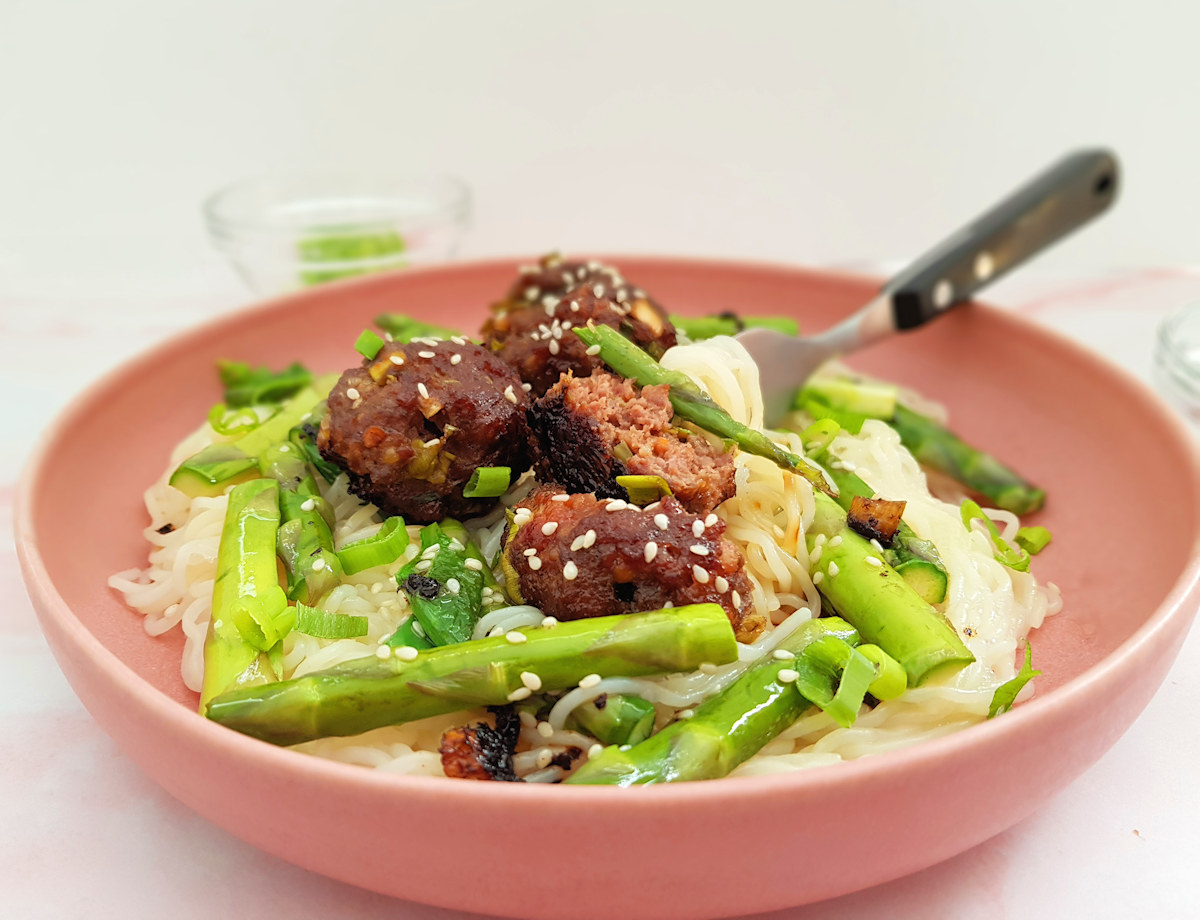Korean barbecue-style beef meatballs with spring onions, ginger and garlic plus a secret old-school meatball ingredient: crushed Ritz crackers.

What you can do with Ritz crackers
I thought it was a joke: Ritz crackers? in meatballs? Korean style too?
First of all, in my mind Ritz crackers were out there with Mini Cheddars and Penguin Bars in the land of kids’ playgrounds. Also the idea of putting crackers into your main course was only a little less laughable than a potato crisp sandwich.
As might have been expected it turns out to be a thing, mainly in America: the stuff of Momma’s cooking and good ole’ nineteen-fifties (not necessarily at the same time). Meatloaf apparently is only tasty when you add crushed Ritz crackers to it instead of boring and tiresome breadcrumbs.
Who makes their own breadcrumbs anyway? and the shop-bought ones are orange and hideous. Ritz crackers however are always there in the cupboard, the familiar red packet that invariably, annoyingly contains just a single cracker left by whoever didn’t want to own up to having eaten the whole box.
Ritz breadcrumbs
I make my own breadcrumbs or source the superior Panko so with a snob’s fascination for junk food I fell upon the idea of Ritz crackers.
So much so I have to admit I have not tried to make the Korean barbecue meatballs with ordinary breadcrumbs to test the Ritz factor, because I adored the original version so much and reach for the Ritz every time I make them.
Disappointingly, they aren’t the key to the fantastic flavour: the combo of soy sauce, ginger, onions and a hint of chilli is. I am however so excited about using Ritz crackers, this dish for ever remains the ‘Ritz meatballs’ in my house.
Tweaking and tinkering
I’ve replicated the NY Times Cooking Kay Chun’s recipe ignoring the low-sodium advice (you want them salty I’m afraid) and upping the heat with ginger and gochujang paste.
I also mixed some extra soy sauce with apricot jam to brush on for the last few minutes of baking, courtesy of invaluable comments underneath the recipe and the outcome exceeded expectations.
Enough said that the amount below which should feed four is usually scoffed between the two of us, only occasionally leaving a meatball or two for the next day’s lunch – incidentally, they are divine cold.
What goes into the Korean BBQ meatballs?
I’m afraid this is one of those annoying recipes that insist on using a thoroughly unusual ingredient nobody ever has in their store cupboard.
Yes indeed, I insist you use gochujang, Korean chilli paste. Trust me – once you’ve used it in one dish, you’ll be using it all the time, not necessarily in Korean or even Asian dishes. It’s simply very good chilli paste with bags of umami.
The only acceptable substitute I can think of is Chinese tobanjan paste.
You can of course skip it, replace it with standard chilli powder or whatever and the meatballs will still be perfectly nice – just not Korean BBQ flavoured.
How to make the meatball mix?
So once you’ve secured gochujang and, of course, the Ritz crackers, the whole mix should be kneaded very thoroughly to combine. Hands are really the best tool for this. Especially that immediately after, you’ll be shaping meatballs with your hands too, about the size of a golf ball each.
The beauty of this recipe is that the meatballs are baked in the oven, there’s no mess or health concern of oil frying.
Towards the end of baking time brush them with an apricot jam-soy sauce glaze and let that glaze bake on them for five minutes or so.
They are lovely served with sesame noodles, plain noodles or rice.
More meatball recipes
Pork and smoky bacon meatballs with tomato flavoured bulgur wheat, a variation on Swedish, Italian and Moroccan meatball classics.
Beef, ricotta and oregano meatballs from Ottolenghi are delicate and light, cooked in a richly flavoured tomato and onion sauce.
Meatball casserole with tomato sauce, Italian style. The recipe is easily scaled up to feed a crowd, the meatball casserole can be served over pasta, rice or with crusty bread. Hearty meatball casserole with zucchini and peppers.
More Korean recipes
Bulgogi, Korean grilled beef served traditionally on lettuce leaves or in flatbread. Use beef sirloin or fillet for the dish and marinate it in sweet, not too spicy marinade so kids will enjoy it too.
Basic kimchi is made with Napa cabbage, called Chinese leaf in the UK. To make kimchi, salt the cabbage, then add spice paste made from gochugaru, Korean chili powder, fish and soy sauce and leave to ferment for up to a week.
Stir-fried cucumbers Asian style, with ginger, garlic and a pinch of chilli. Spicy but also refreshing which is logical as cukes are 96% water.